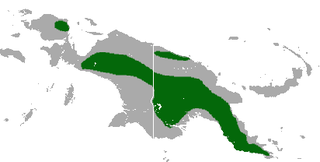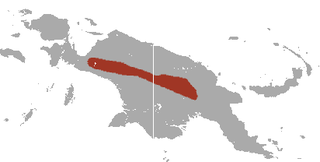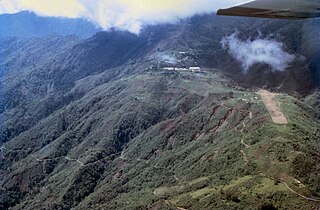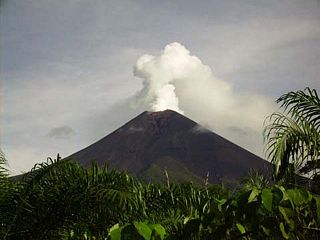
Laurel forest, also called laurisilva or laurissilva, is a type of subtropical forest found in areas with high humidity and relatively stable, mild temperatures. The forest is characterized by broadleaf tree species with evergreen, glossy and elongated leaves, known as "laurophyll" or "lauroid". Plants from the laurel family (Lauraceae) may or may not be present, depending on the location.

The Foja Mountains are located just north of the Mamberamo river basin in Papua, Indonesia. The mountains rise to 2,193 metres (7,195 ft), and have 3,000 square kilometers of old growth tropical rainforest in the interior part of the range. The Foja forest tract covers 9,712 square kilometers and is the largest tropical forest without roads in the Asia Pacific region.
Podocarpus ledermannii is a species of conifer in the family Podocarpaceae. It is found on New Guinea and the Bismarck Archipelago in Indonesia and Papua New Guinea.

The black-tailed dasyure is a species of marsupial in the family Dasyuridae.

The pygmy ringtail possum is a species of marsupial in the family Pseudocheiridae. It is found in the montane forest regions of Papua New Guinea and West Papua, Indonesia. They are "widespread along the Central Cordillera" and live at elevations between 1,500 and 3,600 metres above sea level.”

The New Guinea Highlands, also known as the Central Range or Central Cordillera, is a long chain of mountain ranges on the island of New Guinea, including the island's tallest peak, Puncak Jaya, Indonesia, 16,024 ft (4,884 m), the highest mountain in Oceania. The range is home to many intermountain river valleys, many of which support thriving agricultural communities. The highlands run generally east-west the length of the island, which is divided politically between Indonesia in the west and Papua New Guinea in the east.

The Central Range montane rain forests is a tropical moist forest ecoregion on the island of New Guinea. The ecoregion covers the Central Range of the New Guinea Highlands, which extends along the spine of the island. The montane rain forests of the ecoregion are distinct from the surrounding lowland forests, and are home to many endemic plants and animals.

The Huon Peninsula montane rain forests is a tropical moist forest ecoregion in New Guinea. The ecoregion covers the mountains of northeastern New Guinea's Huon Peninsula.
The Cromwell Mountains is a mountain range on the Huon Peninsula in north-eastern Papua New Guinea.

Castanopsis argentea is an evergreen tree native to Indonesia, where it is known as sarangan. It is native to the islands of Java and Sumatra.
Heptapleurum angiense is a flowering plant in the family Araliaceae. It is a tree endemic to western New Guinea.
Heptapleurum stramineum is a species of flowering plant in the family Araliaceae. It is a scrambling tree endemic to Papua New Guinea.

The Sulawesi montane rain forests is a tropical moist forest ecoregion in Indonesia. It includes the highlands of Sulawesi.

The Vogelkop–Aru lowland rain forests is a tropical moist forest ecoregion in Indonesia. The ecoregion covers the peninsular lowlands of western New Guinea, along with the Aru Islands and other nearby islands.

The Vogelkop montane rain forests is a tropical moist forest ecoregion in western New Guinea. The ecoregion covers the mountains of western New Guinea's Bird's Head and Bomberai peninsulas.

The New Britain–New Ireland montane rain forests is a tropical moist forest ecoregion in Papua New Guinea. The ecoregion includes the mountain rain forests on the islands of New Britain and New Ireland, which lie northeast of New Guinea.

The Northern New Guinea montane rain forests is a tropical moist forest ecoregion in northern New Guinea. The ecoregion covers several separate mountain ranges lying north of New Guinea's Central Range and south of the Pacific Ocean.

The Yapen rain forests is a tropical moist forest ecoregion in Indonesia. The ecoregion covers the island of Yapen and smaller neighboring islands which lie north of New Guinea.
Nothofagus brassii is a species of tree in the family Nothofagaceae. It is endemic to New Guinea. It is commonly known as Sagé, sagé hitam, sahé, and kayu sagé, kayu sagé hitam (Indonesian).
Nothofagus starkenborghiorum is a species of tree in the family Nothofagaceae. It is native to New Guinea and New Britain. It grows in montane rain forests, and occasionally in lowland rain forests.














